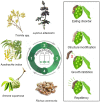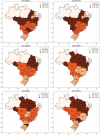Applications and Market of Micro-Organism-Based and Plant-Based Inputs in Brazilian Agriculture
- PMID: 38005741
- PMCID: PMC10675046
- DOI: 10.3390/plants12223844
Applications and Market of Micro-Organism-Based and Plant-Based Inputs in Brazilian Agriculture
Abstract
The use of plant-based and micro-organism-based biological inputs is a sustainable agricultural practice. It promotes a suitable and better utilization of non-renewable resources in the environment. The benefits of using micro-organisms are associated with direct and indirect mechanisms, mainly related to improvements in the absorption and availability of nutrients, resulting in a consequent impact on plant growth. The main benefits of using biochemical pesticides are the promotion of sustainability and the management of resistance to pests and diseases. Although the use of micro-organisms and botanical metabolites is a promising agricultural alternative, they are still primarily concentrated in grain crops. There is a huge opportunity to expand the plant-based and micro-organism-based biological inputs used in agriculture due to the wide range of mechanisms of action of those products. At a global level, several terminologies have been adopted to characterize biological inputs, but many terms used conflict with Brazilian legislation. This review will clarify the classes of biological inputs existing in Brazil as well as present the application and evolution of the market for microbiological and plant-based inputs.
Keywords: biological and biochemical pesticides; crop development; plant growth-promoting micro-organisms (PGPM); seeds inoculation.
Conflict of interest statement
The authors declare no conflict of interest.
Figures









Similar articles
-
Brazilian Amazonian microorganisms: A sustainable alternative for plant development.AIMS Microbiol. 2025 Feb 7;11(1):150-166. doi: 10.3934/microbiol.2025008. eCollection 2025. AIMS Microbiol. 2025. PMID: 40161244 Free PMC article. Review.
-
Exploitation of Plant Growth Promoting Bacteria for Sustainable Agriculture: Hierarchical Approach to Link Laboratory and Field Experiments.Microorganisms. 2022 Apr 21;10(5):865. doi: 10.3390/microorganisms10050865. Microorganisms. 2022. PMID: 35630310 Free PMC article.
-
Plant-Derived Pesticides as an Alternative to Pest Management and Sustainable Agricultural Production: Prospects, Applications and Challenges.Molecules. 2021 Aug 10;26(16):4835. doi: 10.3390/molecules26164835. Molecules. 2021. PMID: 34443421 Free PMC article. Review.
-
PGPR: the treasure of multifarious beneficial microorganisms for nutrient mobilization, pest biocontrol and plant growth promotion in field crops.World J Microbiol Biotechnol. 2023 Feb 16;39(4):100. doi: 10.1007/s11274-023-03536-0. World J Microbiol Biotechnol. 2023. PMID: 36792799 Review.
-
Enhancement of Plant Productivity in the Post-Genomics Era.Curr Genomics. 2016 Aug;17(4):295-6. doi: 10.2174/138920291704160607182507. Curr Genomics. 2016. PMID: 27499678 Free PMC article.
Cited by
-
Effect of Biostimulant, Manure Stabilizer, and Manure on Soil Physical Properties and Vegetation Status.Plants (Basel). 2024 Mar 22;13(7):920. doi: 10.3390/plants13070920. Plants (Basel). 2024. PMID: 38611449 Free PMC article.
References
-
- Santos M.S., Nogueira M.A., Hungria M. Outstanding Impact of Azospirillum brasilense Strains Ab-V5 and Ab-V6 on the Brazilian Agriculture: Lessons That Farmers Are Receptive to Adopt New Microbial Inoculants. Rev. Bras. Ciênc. Solo. 2021;45:e0200128. doi: 10.36783/18069657rbcs20200128. - DOI
-
- Milléo M.V.R., Pandolfo M., Santos D.S., Soares C.R.F.S., Moscardi M.L. Agronomic Efficiency of an Inoculant Based on Bacillus amyloliquefaciens FZB45 for Corn and Soybean Crops. Agraria. 2023;18:1–10. doi: 10.5039/agraria.v18i1a2844. - DOI
-
- Li J., Wang J., Liu H., Macdonald C.A., Singh B.K. Application of Microbial Inoculants Significantly Enhances Crop Productivity: A Meta-analysis of Studies from 2010 to 2020. J. Sustain. Agric. Environ. 2022;1:216–225. doi: 10.1002/sae2.12028. - DOI
-
- Hungria M., Nogueira M.A., Araujo R.S. Co-Inoculation of Soybeans and Common Beans with Rhizobia and Azospirilla: Strategies to Improve Sustainability. Biol. Fertil. Soils. 2013;49:791–801. doi: 10.1007/s00374-012-0771-5. - DOI
Publication types
Grants and funding
LinkOut - more resources
Full Text Sources

